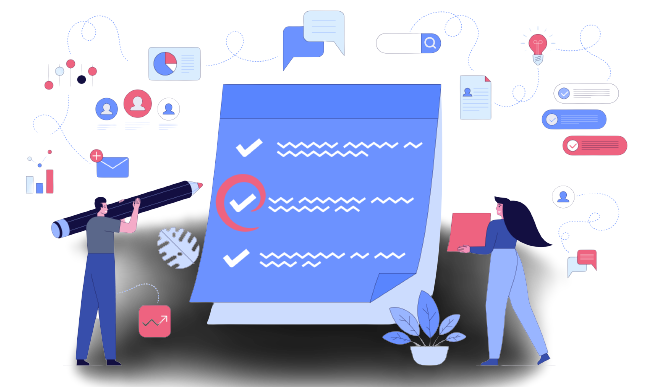
Today, businesses are constantly seeking innovative ways to connect with their target audience. One such approach that has gained prominence is behavior-based marketing automation. This sophisticated strategy combines the power of automation with the insights derived from customer behavior to create highly personalized and effective marketing campaigns. In this blog, we’ll provide an in-depth understanding of what behavior based marketing automation is and why it’s so important in the modern business environment.
What is Behavior-Based Marketing Automation?
At its core, behavior-based marketing automation is a methodology that leverages customer actions, preferences, and interactions to trigger personalized marketing campaigns. It involves the use of specialized software and tools to monitor and respond to customer behavior in real-time. Instead of deploying generic marketing messages to a broad audience, behavior-based automation allows businesses to tailor their marketing efforts to individual customers based on their unique behaviors and interests.
Behavior-based marketing automation operates on the premise that understanding and responding to customer behavior leads to more relevant and engaging interactions. It enables businesses to deliver the right message to the right person at the right time, ultimately driving higher conversion rates and customer satisfaction.
Why is Behavior-Based Marketing Automation Important?

- Personalization at Scale: One of the standout benefits of behavior-based marketing automation is its ability to deliver personalization at scale. It allows businesses to create and manage highly targeted marketing campaigns for thousands or even millions of customers simultaneously. This personalization builds stronger connections and fosters customer loyalty.
- Enhanced Customer Engagement: By tailoring marketing messages and offers to individual behaviors, businesses can capture the attention of customers more effectively. Engaging content and relevant offers increase the likelihood of customers taking desired actions, such as making a purchase or subscribing to a newsletter.
- Improved Conversion Rates: Behavior-based marketing automation excels at converting leads into customers. When customers receive offers or recommendations aligned with their interests and past behaviors, they are more inclined to take action. This leads to improved conversion rates and higher revenue.
- Customer Retention: Effective automation not only attracts new customers but also nurtures existing relationships. By continuously analyzing behavior and responding with relevant content and offers, businesses can keep customers engaged and loyal over the long term.
- Data-Driven Decision Making: Behavior-based automation relies on data analysis. It provides valuable insights into customer behavior patterns, preferences, and trends. Businesses can use these insights to make informed marketing decisions, refine strategies, and stay ahead of the competition.
- Cost-Efficiency: Automation reduces the need for manual, time-consuming marketing tasks. This efficiency translates into cost savings and allows marketing teams to focus on high-impact activities, such as strategy development and creative content creation.
- Adaptation to Customer Journey: Customer journeys are rarely linear. Behavior-based marketing automation adapts to the non-linear nature of the modern customer journey, ensuring that customers receive relevant messages at every stage, from awareness to conversion and beyond.
Thus, behavior-based marketing automation is a strategic approach that empowers businesses to connect with customers on a deeper level by understanding and responding to their behaviors and preferences.
Selecting the Right Marketing Automation Tools for Behavior-Based Strategies

Choosing the right marketing automation tools is a crucial step in implementing behavior-based marketing strategies effectively. These tools serve as the backbone of your automation efforts, enabling you to track, analyze, and respond to customer behavior in a personalized way. In this article, we’ll provide tips for selecting the most suitable marketing automation platform for behavior-based strategies and offer a comparison of different tools available in the market.
Key Considerations for Selecting Marketing Automation Tools
- Behavior Tracking Capabilities: The primary purpose of behavior-based marketing automation is tracking and responding to customer actions. Ensure the chosen tool has robust tracking capabilities to monitor website visits, email opens, click-through rates, and other relevant behaviors.
- User-Friendly Interface: The ease of use is crucial, especially if you have a team of marketers who will be using the tool. Look for an intuitive interface that streamlines campaign setup and management.
- Integration Capabilities: Assess the tool’s compatibility with your existing systems, including CRM software, email marketing platforms, and e-commerce solutions. Seamless integration ensures a unified view of customer data.
- Personalization Features: Effective behavior-based marketing relies on personalization. Check if the tool offers features like dynamic content, segmentation, and personalization capabilities to deliver tailored messages.
- Scalability: Consider your future growth plans. Can the chosen tool scale with your business as your automation needs expand? Scalability is vital to avoid outgrowing the tool too quickly.
- Analytics and Reporting: Robust analytics and reporting tools are essential for measuring the success of your behavior-based campaigns. Ensure the tool provides actionable insights and customizable reports.
- Multi-Channel Support: Today’s customers interact through various channels. Look for a tool that supports multi-channel marketing, including email, social media, SMS, and more.
- Automation Rules: Behavior-based marketing automation relies on setting up rules and triggers. Ensure the tool allows you to create complex automation workflows based on customer behavior.
Comparison of Leading Marketing Automation Tools
To aid in your selection process, here’s a brief comparison of some popular marketing automation tools known for their behavior-based marketing capabilities:
- EQUP:
- EQUP is an emerging marketing automation platform known for its focus on behavior-based marketing.
- Offers powerful behavior tracking and segmentation capabilities.
- Provides personalized messaging and dynamic content features.
- Known for its ease of use and user-friendly interface.
- Suitable for businesses of various sizes, from small startups to larger enterprises.
- Integrates with popular CRM systems for a unified customer view.
- HubSpot:
- Offers a user-friendly interface and robust tracking.
- Provides strong personalization features.
- Integrates well with CRM systems.
- Pardot by Salesforce:
- Known for B2B marketing automation.
- Offers strong lead nurturing and scoring capabilities.
- Integrates seamlessly with Salesforce CRM.
- Marketo:
- Offers advanced behavioral tracking and analytics.
- Supports lead management and nurturing.
- Suitable for mid-sized to enterprise-level businesses.
- ActiveCampaign:
- Known for its affordability and ease of use.
- Provides strong automation and segmentation features.
- Suitable for small to medium-sized businesses.
- Eloqua by Oracle:
- Ideal for large enterprises.
- Offers advanced automation, personalization, and analytics.
- Integrates with Oracle CRM.
- Mailchimp:
- User-friendly and affordable.
- Suitable for small businesses and startups.
- Offers basic behavior-based automation features.
- SendinBlue:
- Known for email and SMS marketing.
- Offers a free plan for small businesses.
- Provides basic automation and personalization.
Each of these marketing automation tools has its unique strengths and may be better suited for different business sizes and needs. Evaluating them based on your specific requirements will help you make an informed decision when selecting the right tool for your behavior-based marketing strategies.
Segmentation and Personalization: Tailoring Your Marketing for Maximum Impact

To truly resonate with your audience, you need to go beyond generic messaging and create marketing campaigns that speak directly to individual preferences and behaviors. Achieving this level of customization is possible through segmentation and personalization. Let’s find out how to segment your audience based on behavior and preferences and then implement personalized marketing campaigns that can yield exceptional results.
Segmentation: The Foundation of Personalization
Segmentation is the process of dividing your audience into distinct groups based on shared characteristics. These characteristics can include demographic data, geographic location, psychographics, and most crucially, behavior and preferences. Here’s how to go about it:
- Data Collection: Begin by collecting comprehensive data about your customers. This can include website interactions, purchase history, email engagement, social media interactions, and more. The more data you have, the more precise your segmentation can be.
- Identify Behavior Patterns: Analyze the data to identify patterns in customer behavior. Look for commonalities, such as frequent website visits, specific product page views, or consistent responses to email campaigns.
- Create Segments: Based on the behavior patterns you’ve identified, create segments or groups of customers who exhibit similar behaviors. For instance, you might have segments like “Frequent Shoppers,” “Email Subscribers,” or “Social Media Engagers.”
- Prioritize Behaviors: Not all behaviors are of equal importance. Prioritize behaviors that are indicative of a customer’s stage in the buying journey or their level of engagement with your brand.
Implementing Personalized Marketing Campaigns

Once you’ve segmented your audience based on behavior and preferences, it’s time to create personalized marketing campaigns that speak directly to these segments:
- Tailored Messaging: Craft marketing messages that are specific to each segment’s behavior and preferences. For example, if you have a segment of “Frequent Shoppers,” send them personalized product recommendations based on their past purchases.
- Email Campaigns: Email marketing is an excellent channel for personalization. Send targeted emails to each segment, showcasing products or content that align with their interests.
- Website Personalization: Use website personalization tools to show different content to different segments. For instance, if a visitor has previously shown interest in technology products, feature tech-related articles or products prominently on your website.
- Dynamic Content: Implement dynamic content in your campaigns, allowing you to change the content of an email or webpage based on the recipient’s behavior or preferences.
- A/B Testing: Continuously test and refine your personalized campaigns. Use A/B testing to determine which messages and offers resonate best with each segment.
- Automation: Leverage marketing automation tools to trigger personalized messages based on specific behaviors. For example, if a customer abandons their cart, an automated email with a tailored incentive can be sent.
- Feedback Loops: Encourage feedback from your customers and use it to further refine your personalization efforts. Learn from their responses and adjust your campaigns accordingly.
Segmentation and personalization are not just buzzwords in modern marketing; they are essential strategies for engaging and retaining customers. By segmenting your audience based on behavior and preferences and then delivering personalized marketing campaigns, you can create a deeper connection with your customers, increase conversion rates, and foster brand loyalty.
Creating Effective Behavioral Triggers
Behavioral triggers are the secret sauce that can elevate your campaigns from mere blasts to highly personalized, engaging experiences. These triggers, rooted in the actions and behaviors of your audience, allow you to deliver the right message to the right person at the right time. Let’s discuss this in detail.
Tips for Defining and Setting Up Behavioral Triggers
- Understand Your Audience: To create effective behavioral triggers, you must first understand your audience’s behaviors, preferences, and pain points. Conduct thorough audience research and segment your audience based on their behaviors and interests.
- Identify Key Behaviors: Pinpoint the specific actions or behaviors that are most relevant to your goals. These could include website visits, email opens, product views, cart abandonment, or social media interactions.
- Set Clear Goals: Define clear objectives for each behavioral trigger. What action do you want the recipient to take in response to the trigger? Whether it’s making a purchase, signing up for a webinar, or downloading a resource, the trigger should align with a specific goal.
- Automation Platform Selection: Choose a marketing automation platform that offers robust behavioral trigger capabilities. Ensure it allows you to set up triggers based on user behavior and supports real-time actions.
- Segmentation is Key: Segmentation is crucial for precision. Divide your audience into segments based on their behaviors and preferences. This allows you to send highly relevant triggers to specific groups.
- Timing Matters: Timing is everything when it comes to behavioral triggers. Set triggers to be sent at the ideal moment when the recipient is most likely to engage, whether it’s immediately after an action or at a later stage in their customer journey.
- Personalize Content: Craft personalized content that corresponds to the triggered behavior. Tailor the message, offer, and call-to-action to resonate with the recipient’s specific interests.
- Testing and Optimization: Continuously monitor the performance of your behavioral triggers. A/B test different trigger criteria, messaging, and timing to identify what works best for your audience.
Examples of Successful Behavioral Trigger Campaigns

- Abandoned Cart Recovery: An e-commerce retailer sends a personalized email to a customer who added items to their cart but didn’t complete the purchase. The email includes images and descriptions of the abandoned products, enticing the customer to return and complete the transaction.
- Welcome Series: A subscription-based service welcomes new subscribers with a series of emails triggered by their sign-up. These emails introduce the service’s features, benefits, and community, nurturing the relationship from the start.
- Product Recommendations: An online bookstore tracks the books a customer views and uses this data to recommend similar titles. These recommendations are sent via email, enticing the customer to explore more and make additional purchases.
- Birthday and Anniversary Offers: A restaurant sends personalized offers to customers on their birthdays or anniversaries, encouraging them to celebrate at the restaurant. The offer includes a discount or a complimentary dessert, creating a memorable experience.
- Re-Engagement Campaign: A software company identifies users who haven’t logged in for a while and triggers a re-engagement email with tips, updates, and incentives to return to the platform. This campaign helps reactivate dormant users.
In these examples, behavioral triggers have been skillfully utilized to engage customers with personalized, timely messages. Each trigger corresponds to a specific behavior or event and is designed to achieve a particular goal, whether it’s recovering abandoned carts, welcoming new subscribers, or re-engaging inactive users.
Integration with CRM Systems: Enhancing Behavior-Based Marketing Automation
Understanding your customers on a deeper level and delivering personalized experiences is the key to success. This is where behavior-based marketing automation shines. By tracking and responding to customer actions, it allows businesses to tailor their marketing efforts in real time. However, the true power of behavior-based marketing automation emerges when it’s integrated with Customer CRM systems. We will explore the importance of this integration and how CRM data enhances behavior-based marketing strategies.
The Significance of CRM Integration
- Holistic Customer View
- CRM systems serve as a repository for comprehensive customer data. This includes contact information, purchase history, communication preferences, and more. When behavior-based marketing automation is integrated with CRM, marketers gain access to this wealth of information.
- The result? A holistic view of each customer that includes both historical data and real-time behavior. This enables marketers to craft highly personalized and relevant messages.
- Seamless Data Flow
- Integration ensures that data flows seamlessly between the behavior-based marketing automation platform and the CRM system. This eliminates data silos, reduces manual data entry, and minimizes errors.
- A unified database enables marketers to segment their audience more effectively based on both demographic and behavioral criteria.
- Enhanced Lead Scoring
- CRM data can be used to refine lead-scoring models. By factoring in CRM information, such as lead source, company size, or industry, along with behavioral data like website visits and email engagement, you can create more accurate lead scores.
- This allows sales teams to prioritize leads based on their likelihood to convert, leading to higher conversion rates.
- Customized Customer Journeys
- With CRM data integrated into your behavior-based marketing automation, you can design highly customized customer journeys. For instance, if a CRM record indicates that a customer recently made a purchase, the automation can send a follow-up email with product recommendations or request a review.
- This level of personalization is hard to achieve without CRM integration.
How CRM Data Enhances Behavior-Based Strategies
- Improved Targeting
- CRM data offers a treasure trove of information about customer preferences, purchase history, and engagement patterns. This data can be used to refine behavioral triggers and segment audiences with precision.
- Enhanced targeting ensures that the right message reaches the right person at the right time.
- Better Lead Nurturing
- CRM data provides insights into where leads are in the sales funnel. Are they just exploring options, or are they ready to make a purchase? Behavior-based marketing automation can leverage this information to deliver nurturing sequences tailored to each lead’s stage in the buyer’s journey.
- Personalized Content Recommendations
- CRM data can reveal past purchases and customer preferences. Behavior-based marketing automation can use this data to suggest relevant products, services, or content.
- This level of personalization increases the chances of cross-selling and upselling.
- Enhanced Reporting and Analytics
- Integrating CRM data into your marketing automation platform allows for more comprehensive reporting and analytics. You can track the entire customer journey from initial contact to conversion and beyond.
- This data-driven approach helps refine marketing strategies over time, optimizing ROI.
Conclusion
Integrating behavioral marketing automation with CRM systems is ideal for businesses looking to elevate their marketing efforts. It enables marketers to harness the full potential of customer data, providing insights for highly personalized and effective campaigns. In the competitive world of modern marketing, this integration is not just an advantage; it’s a necessity for staying ahead and delivering exceptional customer experiences. By combining behavioral insights with CRM data, businesses can create marketing strategies that resonate with customers on a profound level, fostering loyalty and driving growth.